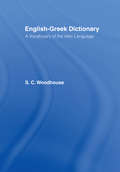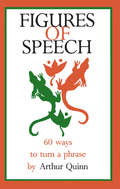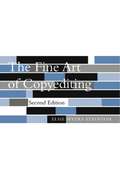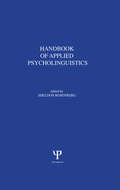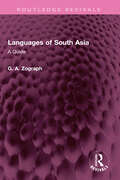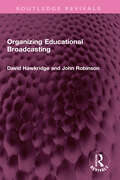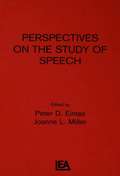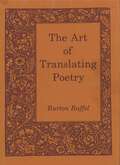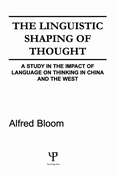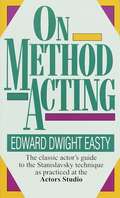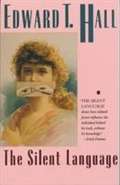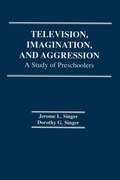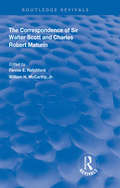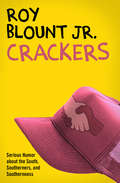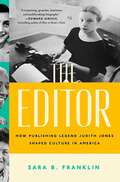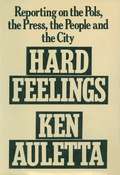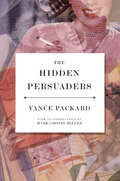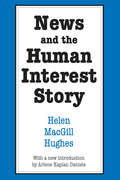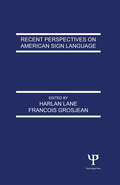- Table View
- List View
Cultures in Contact: Studies in Cross-cultural interaction
by Stephen BochnerAlthough dated, this text presents research regarding cross-cultural interaction.
English-Greek Dictionary: With a Supplement of Proper Names Including Greek Equivalents for Famous Names in Roman History
by S. C. WoodhouseFirst published in 1998. Routledge is an imprint of Taylor & Francis, an informa company.
Figures of Speech: 60 Ways To Turn A Phrase
by Arthur QuinnWriting is not like chemical engineering. The figures of speech should not be learned the same way as the periodic table of elements. This is because figures of speech are not about hypothetical structures in things, but about real potentialities within language and within ourselves. The "figurings" of speech reveal the apparently limitless plastic
The Fine Art of Copyediting (2nd Edition)
by Elsie Myers StaintonIncludes Advice To Editors On How To Get Along With Authors, And Tips On Style For Both.
Handbook of Applied Psycholinguistics: Major Thrusts of Research and Theory
by Sheldon RosenbergFirst published in 1982. The chapters of this handbook contain critical integrative reviews of research and theory in the major areas of the field of applied psycholinguistics, the field in which applied problems of language and communicative functioning and development are approached from the standpoint of basic research and theory in psycholinguistics and related areas of cognitive psychology. The book was designed to meet the needs of researchers, practitioners and graduate students from such disciplines as education (including special education), language learning, linguistics, neurology, psychiatry, psychology, and speech and hearing for such reviews, although the state of research in an area and a desire to stress research and theory in substantive areas resulted in a decision not to include chapters on the measurement of linguistic maturity, language intervention, the language of the learning disabled child, language and environmental deprivation, language and mania, language and senile dementia, and the design of written and oral information and computer command language.
Languages of South Asia: A Guide (Routledge Revivals)
by G. A. ZographFirst published in 1982, Languages of South Asia covers all important languages and language groups of the so-called Indian subcontinent (India, Bangladesh, Pakistan, Sri Lanka, Nepal and Bhutan). It concentrates on the more southern languages, that is the Indo-Aryan, Dravidian and Munda groups; a brief survey of Tibeto-Burman languages is also included. As well as giving a description of the current status and character of each language, Dr. Zograph goes into a detailed structural analysis of its phonology, morphology and syntax. The problems of the historical background of the modern languages, and their classification, are also discussed. The book is supplemented by two language maps, tables showing the main alphabets, a bibliography of reliable works on the subject and an index of 350 language names used in the text. This book will be of interest to students of language, linguistics and South Asian studies.
Organizing Educational Broadcasting (Routledge Revivals)
by David Hawkridge John RobinsonFirst published in 1982, Organizing Educational Broadcasting provides advice and guidance in organizational and managerial skills for those responsible for the operation of educational broadcasting systems. It is principally designed for those who actually work within educational radio and television systems. They are the people who perhaps stand to gain most by reading about international case studies. In addition, high-level decision-makers, planners and others who are concerned with conceptualizing, planning and implementing new systems, or more likely, modifying old ones, will find much to interest them.
Perspectives on the Study of Speech
by Peter D. Eimas, Joanne L. MillerPublished in the year 1982, Perspectives on the Study of Speech is a valuable contribution to the field of Cognitive Psychology.
The Art of Translating Poetry
by Burton RaffelThis book by a well-known translator and critic is divided into two parts, the first dealing with the linguistic and other more technical aspects of translating poetry, the second involved with more practice-oriented matters. The chapters in Part One examine the specific constraints of language and the unavoidable linguistic bases of translation; the constraints of specific languages; forms and genres; and prosody and comparative prosody. Part Two looks at the subjective element in translation; collaborative translation; the translation of oral poetry; and the translator's responsibility.Languages discussed include Indonesian, Japanese, Chinese, Old and Middle English, French, German, Spanish, Italian, Persian, Russian, Latin, and Greek. The book argues, inter alia, that literal translation is impossible; that no translation can fully create the original but that good literary translation can create a usable approximation; that translation is secondary not only to the original work being translated but also to the linguistic (and literary) nature of the language being translated into; that the literary translator's primary responsibility is to the work he is translating; that there is nothing ever definitive about any translation; that the poetry translator must be a poet and poems should not be translated into prose; and that there must be a subjective identification between translator and translated work.This is the first attempt to systematize linguistic information about the translation of poetry. It is also the first book to range widely over the languages and literatures of the past and the present, and European and Asian languages and literatures as well. Raffel is the first author to combine in one study linguistic and scholarly knowledge and extensive experience of translation.
Best Newspaper Writing 1981
by Roy P. ClarkBest Newspaper Writing 1981 celebrates the winners of the ASNE's Distinguished Writing Awards, including the Jesse Laventhol Awards, created to honor deadline reporting. It includes interviews with the winners about their craft; the work of 17 other writers who share the lessons they learned; study questions useful to students, teachers, and working journalists; a bibliography; and essays to help readers improve their writing.
The Linguistic Shaping of Thought: A Study in the Impact of Language on Thinking in China and the West
by A. H. Bloom Alfred H. BloomFirst published in 1981. Routledge is an imprint of Taylor & Francis, an informa company.
On Method Acting: The Classic Actor's Guide to the Stanislavsky Technique as Practiced at the Actors Studio
by Ward DwightPracticed by such actors of stature as Marlon Brando, Robert De Niro, Julie Harris, Dustin Hoffman, and Ellen Burstyn (not to mention the late James Dean) the Method offers a practical application of the renowned Stanislavsky technique.On Method Acting demystifies the "mysteries" of Method acting -- breaking down the various steps into clear and simple terms, including chapters on:Sense Memory -- the most vital component of Method actingImprovisation -- without it, the most integral part of the Method is lostAnimal Exercises -- just one way to combat the mental blocks that prevent actors from grasping a characterCreating The Outer Character -- so actors can give the freshness of originality to a role while at the same time living the life of the characterOn Method Acting is also an indispensable volume for directors, designers, lighting technicians, and anyone in the dramatic arts interested in creating a believable and realistic effect in their productions.
The Silent Language
by Edward T. HallIn the everyday, but unspoken give-and-take of human relationships, the "silent language" plays a vitally important role. Here, a leading American anthropologist has analyzed the many ways in which people "talk" to one another without the use of words. The pecking order in a chicken yard, the fierce competition in a school playground, every unwitting gesture and action--this is the vocabulary of the "silent language. " According to Dr. Hall, the concepts of space and time are tools with which all human beings may transmit messages. Space, for example, is the outgrowth of an animal's instinctive defense of his lair and is reflected in human society by the office worker's jealous defense of his desk, or the guarded, walled patio of a Latin-American home. Similarly, the concept of time, varying from Western precision to Easter vagueness, is revealed by the businessman who pointedly keeps a client waiting, or the South Pacific islander who murders his neighbor for an injustice suffered twenty years ago. THE SILENT LANGUAGE shows how cultural factors influence the individual behind his back, wihtout his knowledge.
Television, Imagination, and Aggression: A Study of Preschoolers
by D. G. SingerFirst Published in 1981. Routledge is an imprint of Taylor & Francis, an informa company.
The Art of Asking Questions
by Stanley PayneWhile the statisticians are trying to knock a few tenths off the statistical error, says Mr. Payne, errors of tens of percents occur because of bad question wording. Mr. Payne's shrewd critique of the problems of asking questions reveals much about the nature of language and words, and a good deal about the public who must answer the poller's questions.
A Choice of Days: Essays from Happy Days, Newspaper Days, and Heathen Days
by H. L. MenckenA series of essays on the writing of the autobiographical book.
The Correspondence of Sir Walter Scott and Charles Robert Maturim (Routledge Revivals)
by Fannie E. Ratchford William H. McCarthyOriginally published in 1937, The Correspondence of Sir Walter Scott and Charles Robert Maturin contains twenty-two letters presenting a penetrating and vivid self-portrait of Sir Walter Scott. Scott's patronage of Maturin, this impecunious Irish author, giving him wise advice, lending encouragement in his work and at times badly needed financial assistance, extended over a period of twelve years to the time of Maturin's death, and his kind subsequent letters, written to Maturin's family, in the midst of his own great financial troubles, bring to a fitting close this single unit in Scott's rich social life. Since the two men never met, the whole relationship was built up through thier literary work and their letters to each other, displayed in this volume.
Crackers
by Roy Blount Jr.An indispensible guide to southernness from revered humorist and unapologetic curmudgeon Roy Blount Jr.When a simple-talking, peanut-warehousing, grit-eating Southern Baptist Cracker got himself nominated for president of the United States in 1976, it set Roy Blount Jr. to thinking--about the South, about southerners, and about southernness. The result is a collection of savagely funny and insightful takes on redneck heaven, whiskey, blood, possums, and a great number of other things.Blount turns his gimlet eye on his Dixie home, and in the process, he clears up long-held misconceptions (and creates new ones) about the people who reside below the Mason-Dixon line. Crackers delivers classic Blount, whether you are a proud southerner or a clueless Yankee.
The Editor: How Publishing Legend Judith Jones Shaped Culture in America
by Sara B. Franklin&“A surprising, granular, luminous, and path-breaking biography.&” —Edward Hirsch, critic and author of How to Read a Poem Legendary editor Judith Jones, the woman behind some of the most important authors of the 20th century—including Julia Child, Anne Frank, Edna Lewis, John Updike, and Sylvia Plath—finally gets her due in this intimate biography.When twenty-five-year-old Judith Jones began working as a secretary at Doubleday&’s Paris office in 1949, she spent most of her time wading through manuscripts in the slush pile and passing on projects—until one day, a book caught her eye. She read it in one sitting, then begged her boss to consider publishing it. A year later, Anne Frank: The Diary of a Young Girl became a bestseller. It was the start of a culture-defining career in publishing. During her more than fifty years as an editor at Knopf, Jones nurtured the careers of literary icons such as Sylvia Plath, Anne Tyler, and John Updike, and helped launched new genres and trends in literature. At the forefront of the cookbook revolution, she published the who&’s who of food writing: Edna Lewis, M.F.K. Fisher, Claudia Roden, Madhur Jaffrey, James Beard, and, most famously, Julia Child. Through her quiet and tenacious work behind the scenes, Jones helped turn these authors into household names, changing cultural mores and expectations along the way. Judith&’s work spanned decades of America&’s most dramatic cultural change—from the end of World War II through the Cold War, from the civil rights movement to the fight for women&’s equality—and the books she published acted as tools of quiet resistance. Now, her astonishing career is explored for the first time. Based on exclusive interviews, never-before-seen personal papers, and years of research, The Editor tells the riveting behind-the-scenes narrative of how stories are made, finally bringing to light the audacious life of one of our most influential tastemakers.
The Gentle Art of Verbal Self-Defense
by Suzette Haden ElginDon't turn the other cheek and fume quietly; know what to say when someone throws out the snide backhanded "compliment," subtle insult, cruel criticism, or outright verbal blow.
Hard Feelings: Reporting on Pols, the Press, People and New York
by Ken AulettaKen Auletta's memoir about his time as a reporter.
The Hidden Persuaders
by Mark Crispin Miller Vance Packard"One of the best books around for demystifying the deliberately mysterious arts of advertising."--Salon"Fascinating, entertaining and thought-stimulating."--The New York Times Book Review"A brisk, authoritative and frightening report on how manufacturers, fundraisers and politicians are attempting to turn the American mind into a kind of catatonic dough that will buy, give or vote at their command--The New YorkerOriginally published in 1957 and now back in print to celebrate its fiftieth anniversary, The Hidden Persuaders is Vance Packard's pioneering and prescient work revealing how advertisers use psychological methods to tap into our unconscious desires in order to "persuade" us to buy the products they are selling.A classic examination of how our thoughts and feelings are manipulated by business, media and politicians, The Hidden Persuaders was the first book to expose the hidden world of "motivation research," the psychological technique that advertisers use to probe our minds in order to control our actions as consumers. Through analysis of products, political campaigns and television programs of the 1950s, Packard shows how the insidious manipulation practices that have come to dominate today's corporate-driven world began. Featuring an introduction by Mark Crispin Miller, The Hidden Persuaders has sold over one million copies, and forever changed the way we look at the world of advertising.Vance Packard (1914-1996) was an American journalist, social critic, and best-selling author. Among his other books were The Status Seekers, which described American social stratification and behavior, The Waste Makers, which criticizes planned obsolescence, and The Naked Society, about the threats to privacy posed by new technologies.
News and the Human Interest Story
by Helen MacGill HughesIn this account of the growth of newspapers in modern, industrial society, Helen Hughes traces the development of a mass audience through analysis of the origins of the human interest story in the popular ballads of an earlier day. She shows how such commonly found interests as a taste for news of the town, ordinary gossip, and moving or gripping tales with a legendary or mythic quality have reflected the tastes of ordinary folk from the days of illiterate audiences to the present. She explains how these interests ultimately were combined with practical economic and political information to create the substance and demand for a popular press.In describing the rise and fall of newspaper empires, each with their special readership attractions, Hughes shows how technological innovation and idiosyncratic creativity were used by owners to capture and hold a reading audience. Once this audience developed, it could be fed a variety of messages—beamed at reinforcing and maintaining both general and specific publics—as well as a view of the world consonant with that of the publisher and major advertisers. Hughes offers a persuasive argument for the continuing viability of this method for combined social control, instruction, and amusement captured by the association of news and the human interest story.
Recent Perspectives on American Sign Language
by Francois Grosjean Harlan L. LanePublished in 1989, Recent Perspectives on American Sign Language is a valuable contribution to the field of Cognitive Psychology.
Shakespeare and Company
by Sylvia BeachSylvia Beach was intimately acquainted with the expatriate and visiting writers of the "Lost Generation", a label that she never accepted. Like moths of great promise, they were drawn to her well-lighted bookstore and warm hearth on the Left Bank. Shakespeare and Company evokes the zeitgeist of an era through its revealing glimpses of James Joyce, Ernest Hemingway, Scott Fitzgerald, Sherwood Anderson, Andre Gide, Ezra Pound, Gertrude Stein, Alice B. Toklas, D. H. Lawrence, and others already famous or soon to be. In his introduction to this new edition, James Laughlin recalls his friendship with Sylvia Beach. Like her bookstore, his publishing house, New Directions, is considered a cultural touchstone.

